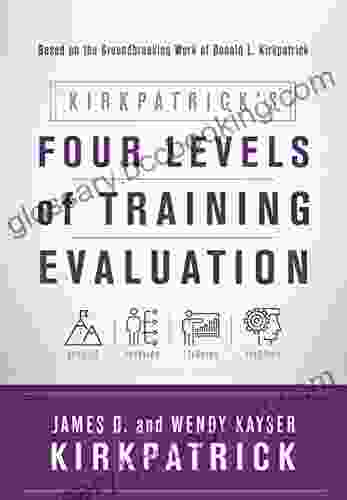Unlocking Training Success: The Kirkpatrick Four Levels of Training Evaluation

In today's competitive business landscape, organizations are increasingly investing in training and development initiatives to enhance employee performance and drive organizational growth. However, measuring the true impact of training programs remains a persistent challenge. Enter the Kirkpatrick Four Levels of Training Evaluation, a comprehensive framework that provides a structured approach to assessing the effectiveness of training interventions.
4.7 out of 5
| Language | : | English |
| File size | : | 27970 KB |
| Text-to-Speech | : | Enabled |
| Screen Reader | : | Supported |
| Enhanced typesetting | : | Enabled |
| X-Ray | : | Enabled |
| Word Wise | : | Enabled |
| Print length | : | 365 pages |
Level 1: Reaction
The first level of evaluation focuses on the participants' immediate reactions to the training program. This includes their overall satisfaction, engagement, and perceptions of the training's relevance and applicability to their roles. It is essential to gather feedback on whether the training met their expectations, piqued their interest, and held their attention throughout.
Level 2: Learning
Moving beyond subjective reactions, the second level evaluates the knowledge and skills gained as a direct result of the training. Cognitive tests, performance assessments, and self-reported learning outcomes can be used to measure the extent to which participants have acquired new information, improved existing skills, or changed their attitudes. This level provides insights into the transfer of learning from the training environment to the workplace.
Level 3: Behavior
The third level assesses the actual behavioral changes exhibited by participants after completing the training. This can be measured through observations, performance reviews, or surveys that track changes in specific behaviors related to the training objectives. It is important to determine whether the training has translated into improved job performance, increased productivity, or enhanced teamwork.
Level 4: Results
The ultimate goal of any training program is to produce tangible results for the organization. The fourth level of evaluation focuses on measuring the broader impact of training on business outcomes such as increased sales, reduced costs, improved customer satisfaction, or enhanced employee retention. This level requires linking training initiatives to specific business goals and demonstrating the return on investment (ROI) of the training program.
Benefits of the Kirkpatrick Model
The Kirkpatrick Four Levels of Training Evaluation offers several key benefits:
- Comprehensive Evaluation: Provides a comprehensive assessment of training effectiveness from multiple perspectives, including reactions, learning, behavior, and results.
- Objective Data: Relies on specific metrics and data collection methods to provide reliable and objective measures of training impact.
- ROI Measurement: Facilitates the measurement of the financial return on investment for training programs, justifying training expenditures.
- Continuous Improvement: Provides ongoing feedback that can be used to refine and improve training programs, ensuring continuous improvement.
- Stakeholder Engagement: Involves stakeholders at all levels in the evaluation process, fostering buy-in and a shared understanding of training effectiveness.
Applying the Kirkpatrick Model
To effectively apply the Kirkpatrick Four Levels of Training Evaluation, follow these steps:
- Define Training Objectives: Clearly articulate the desired outcomes of the training program, aligned with specific business goals.
- Select Evaluation Methods: Choose appropriate data collection methods and tools for each level of evaluation, based on the specific training objectives.
- Collect and Analyze Data: Gather data from participants, managers, and relevant stakeholders throughout the evaluation process.
- Interpret and Communicate Results: Analyze the data and present clear and concise findings, highlighting the strengths and areas for improvement of the training program.
- Make Recommendations: Based on the evaluation results, provide specific recommendations for改进ing the training program or leveraging its successes.
The Kirkpatrick Four Levels of Training Evaluation is an invaluable tool for organizations seeking to maximize the impact of their training investments. By systematically assessing the reactions, learning, behavior, and results of training programs, organizations can gain valuable insights into the effectiveness of their initiatives and make informed decisions to improve training outcomes. Embracing the Kirkpatrick model empowers organizations to unlock training success and drive sustainable organizational growth.
4.7 out of 5
| Language | : | English |
| File size | : | 27970 KB |
| Text-to-Speech | : | Enabled |
| Screen Reader | : | Supported |
| Enhanced typesetting | : | Enabled |
| X-Ray | : | Enabled |
| Word Wise | : | Enabled |
| Print length | : | 365 pages |
Do you want to contribute by writing guest posts on this blog?
Please contact us and send us a resume of previous articles that you have written.
 Book
Book Novel
Novel Page
Page Chapter
Chapter Text
Text Story
Story Genre
Genre Reader
Reader Library
Library Paperback
Paperback E-book
E-book Magazine
Magazine Newspaper
Newspaper Paragraph
Paragraph Sentence
Sentence Bookmark
Bookmark Shelf
Shelf Glossary
Glossary Bibliography
Bibliography Foreword
Foreword Preface
Preface Synopsis
Synopsis Annotation
Annotation Footnote
Footnote Manuscript
Manuscript Scroll
Scroll Codex
Codex Tome
Tome Bestseller
Bestseller Classics
Classics Library card
Library card Narrative
Narrative Biography
Biography Autobiography
Autobiography Memoir
Memoir Reference
Reference Encyclopedia
Encyclopedia Jackalina G
Jackalina G James Gee
James Gee Ronnie Kasrils
Ronnie Kasrils Nicola Busby
Nicola Busby Jakob Schwichtenberg
Jakob Schwichtenberg James Arena
James Arena Petr Zima
Petr Zima Tetsuya Nomura
Tetsuya Nomura James Graham
James Graham James Ferguson
James Ferguson Jonathan Knight
Jonathan Knight Scott D Smith
Scott D Smith James Lythgoe
James Lythgoe Rayner Teo
Rayner Teo James Zug
James Zug Julie Kling
Julie Kling Kurt Jacobs
Kurt Jacobs Jeff Driscoll
Jeff Driscoll Richard A Horsley
Richard A Horsley Jesse Martin
Jesse Martin
Light bulbAdvertise smarter! Our strategic ad space ensures maximum exposure. Reserve your spot today!

 Federico García LorcaFad Fashion and Science in Professional Practice: A Transformative Guide for...
Federico García LorcaFad Fashion and Science in Professional Practice: A Transformative Guide for...
 Ronald SimmonsUnveiling the Secrets of 'The Chimera Jar: The Aegis of Merlin'—A Journey...
Ronald SimmonsUnveiling the Secrets of 'The Chimera Jar: The Aegis of Merlin'—A Journey... Harold BlairFollow ·16.5k
Harold BlairFollow ·16.5k Gavin MitchellFollow ·9.4k
Gavin MitchellFollow ·9.4k John MiltonFollow ·3.4k
John MiltonFollow ·3.4k Gene SimmonsFollow ·10k
Gene SimmonsFollow ·10k Reed MitchellFollow ·9.2k
Reed MitchellFollow ·9.2k Felix CarterFollow ·6.3k
Felix CarterFollow ·6.3k Ricky BellFollow ·14.9k
Ricky BellFollow ·14.9k Tony CarterFollow ·7.8k
Tony CarterFollow ·7.8k

 Douglas Adams
Douglas AdamsGingerbread Friends by Jan Brett
A Magical Tale for the Holidays Jan Brett's...

 Joseph Foster
Joseph FosterHappy Birthday Moo Moo Family: A Delightful Tale for Kids...
Celebrate the Bonds of Family with...

 Demetrius Carter
Demetrius CarterUncover the Enchanting Tapestry of New Delhi: A Visual...
New Delhi, India's vibrant capital, is a...

 W.B. Yeats
W.B. YeatsUnveiling the Power of Lean UX: A Comprehensive Review of...
In the rapidly evolving world...
4.7 out of 5
| Language | : | English |
| File size | : | 27970 KB |
| Text-to-Speech | : | Enabled |
| Screen Reader | : | Supported |
| Enhanced typesetting | : | Enabled |
| X-Ray | : | Enabled |
| Word Wise | : | Enabled |
| Print length | : | 365 pages |












